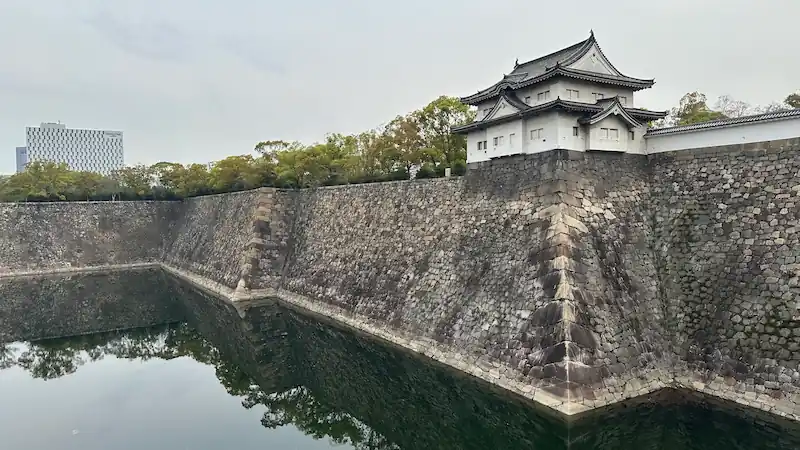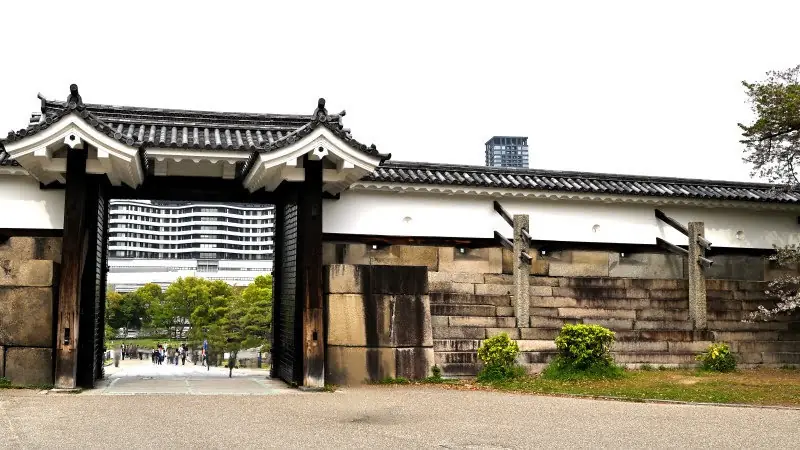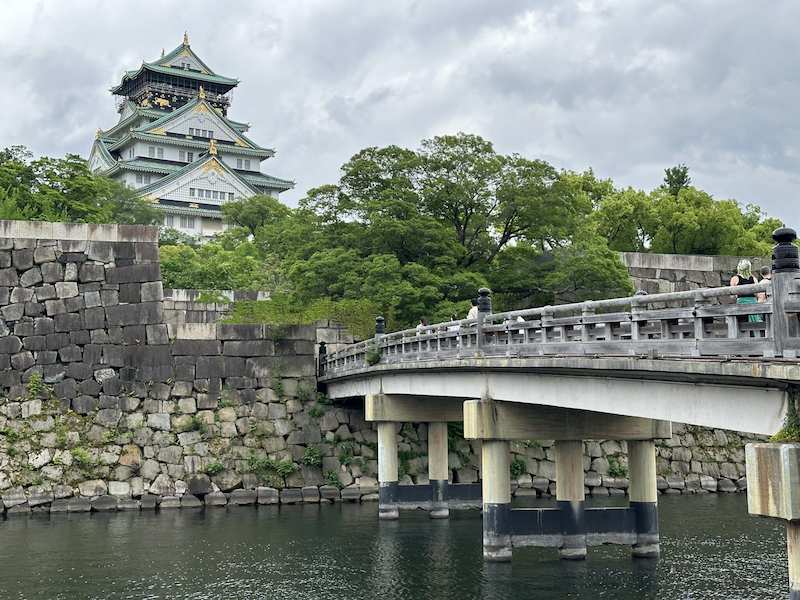Otemon Gate – Tamon Turret
Serving as the grand main entrance to Osaka Castle, the Otemon Gate area captures the strategic brilliance of the fortress’s design as reconstructed by the Tokugawa Shogunate. Highlights include the Otemon Gate, a powerful symbol of the castle’s authority and prestige; the masugata, a square enclosure engineered to trap and disorient intruders; and the colossal Takoishi—one of Japan’s largest hewn stones, one of the largest stones in Japan.
The design illustrates the essence of Osaka Castle’s defensive strategy through the south and north walls, which feature kokuinseki—engraved stones bearing marks from various feudal lords and stonemasons—and the Tamon Turret, an Important Cultural Property, along with its adjoining northern moat.
Tamon Yagura Northern Moat

⭐ Recommendation Rating
- Historical Significance: ☆☆
- Visual Appeal: ☆☆☆
- Experiential Value: ☆☆
🏛 Overview
The Northern Wall of the Tamon Turret is a key defensive structure extending from the north side of the Tamon Yagura at Osaka Castle. Because the turret itself was used to store weapons and provisions, this adjoining wall was constructed with particular emphasis on strength and security. The current structure was rebuilt by the Tokugawa Shogunate in the early 17th century, though its foundation is believed to incorporate design principles from the original Toyotomi-era Osaka Castle.
Architecturally, the wall prioritizes both protection and concealment—features essential in feudal castle defense. The height and thickness of the wall reflect the most advanced construction techniques of the time. Toyotomi Hideyoshi’s vision of an “impregnable castle” lived on through the Tokugawa reconstruction, and that legacy is visible even in subtle architectural details like this northern fortification. Today, the carefully preserved wall, with its a dramatic interplay of heavy stone and soft white plaster, still leaves a lasting impression on visitors today.
| Year Built | Rebuilt in 1628 (Edo period) |
|---|---|
| Builder | Tokugawa Shogunate |
| Structure/Features | Massive stone wall with white plaster upper section; designed for defense and concealment |
| Renovation/Restoration | Rebuilt in 1628; preserved in current form since then |
| Current Status | Well-preserved; part of Osaka Castle’s Important Cultural Properties |
| Destruction/Damage | Original structure destroyed during the 1615 Siege of Osaka |
| Cultural Property Designation | Important Cultural Property (Tamon Yagura) |
| Remarks | Strategically connects Tamon Yagura to the northern moat; features high-quality Aji stone in its foundation |
🗺 Address:
Osaka Castle 1-1, Chuo-ku, Osaka City, Osaka Prefecture, North Wall of Tamon Yagura
🚶 Access: Approx. 13 minutes walk (approx. 0.9km) from Osaka Metro Tanimachi 4-Chome Station
⏳ Estimated time for sightseeing
: Short sightseeing: About 5 minutes
If you want to take your time sightseeing: About 15 minutes (including observing the connections with the turrets and stone walls)
📍 Highlights
🔹 Structural junctions: A close look reveals how the Tamon Turret seamlessly connects with the northern wall—an architectural detail sure to fascinate fans of Japanese castle design.
🔹 White plaster aesthetics: The color of the white plaster subtly shifts with the changing sunlight throughout the day, creating a dynamic and atmospheric visual experience.
🔹 Seasonal contrast: The white walls stand in striking contrast to the surrounding scenery—delicate cherry blossoms in spring and vivid red foliage in autumn—making it a favorite spot for photographers.
📌 Trivia
🔹 Hidden history: According to one theory, a space behind this wall once served as a gunpowder storehouse, suggesting the area was of high strategic secrecy.
🔹 Stone of distinction: The foundation stones include high-quality Aji stone, a premium granite transported by ship from the Seto Inland Sea—a testament to the care taken in material selection.
🔹 Historical patrols: Records show that during the Edo period, senior Tokugawa retainers patrolled this area as part of the castle’s internal security inspections, offering a glimpse into its tense atmosphere at the time.
Otemon Gate

⭐ Recommendation Rating
- Historical Significance: ☆☆☆
- Visual Appeal: ☆☆☆
- Experiential Value: ☆☆
🏛 Overview
The Otemon Gate once served as the main entrance to Osaka Castle—a formidable gateway once traversed by samurai and dignitaries alike The gate as seen today was rebuilt by the Tokugawa Shogunate in the early Edo period, but its foundation overlaps with remnants of the original Osaka Castle constructed by Toyotomi Hideyoshi. As the base of Hideyoshi’s campaign to unify Japan, Osaka Castle was a powerful symbol of his authority and aesthetic sensibility—and the Otemon Gate was a key component of that legacy. The massive stone walls and sturdy wooden gates combined both defensive strength and visual intimidation, making the gate architecturally significant.
The Otemon Gate also features a strategic defensive layout known as a masugata—a box-shaped enclosure designed to trap and confuse intruders. Even today, the precision of its construction and the historical weight it carries continue to captivate visitors.
| Year Built | Rebuilt in the early Edo period (circa 1620s) |
|---|---|
| Builder | Tokugawa shogunate engineers |
| Structure/Features | Masugata-style gate with Tamon Yagura turret and stone walls |
| Renovation/Restoration | Multiple restorations; walls and turret maintained since Edo period |
| Current Status | Tamon Yagura remains original; Otemon partially reconstructed |
| Destruction/Damage | Original Toyotomi structures destroyed in the 1615 Siege of Osaka |
| Cultural Property Designation | Important Cultural Property (Tamon Yagura) |
| Remarks | Serves as the symbolic entrance to Osaka Castle |
🗺 Address:
1-1 Osakajo, Chuo-ku, Osaka City, Osaka Prefecture
🚶 Access: Approx. 1 minutes walk (approx. 20m) from Tamon Yagura Northern Moat
⏳ Estimated
time to visit: Short tour: About 5 minutes.
If you want to explore the area thoroughly: About 15 minutes (including the surrounding stone walls and gate structure).
📍 Points of Interest
🔹 Masugata layout: A defensive design that forces the enemy to turn at right angles inside the gate area. Standing here gives a tangible sense of historical strategy.
🔹 Takoishi (Giant Stone Block): One of Japan’s largest stones, weighing about 130 tons. How it was transported remains a mystery.
🔹 Gate doors and metalwork: Decorative metal fittings on the heavy wooden doors reflect both the craftsmanship and the aesthetic priorities of the period.
🔹 Seasonal Highlights: In spring, cherry blossoms bloom around the gate, making it a popular photo spot. In autumn, the contrast between the foliage and the stone walls creates a stunning view.
📌 Trivia
🔹 Unexpected historical background: The current Otemon Gate was rebuilt by the Tokugawa Shogunate in 1628, not during Hideyoshi’s time. However, some of the original Toyotomi-era stonework was reused in its foundations.
🔹 Little-known detail: On the southern side of the gate, you’ll find a kokuinseki—a carved stone bearing a stonemason’s name or family crest, acting like a signature or work record.
🔹 Connections with historical figures: Famous retainers like Sen no Rikyu and Kuroda Kanbei were closely involved with Toyotomi Hideyoshi’s court. Imagining them passing through this very gate brings the history to life.
South wall of Otemon Gate

⭐ Recommendation Rating
- Historical Significance: ☆☆
- Visual Appeal: ☆☆
- Experiential Value: ☆☆
🏛 Overview
The Otemon Southern Wall is a long defensive wall located just south of the Otemon Gate at Osaka Castle. It was constructed as part of the castle’s outer fortifications during the Tokugawa Shogunate’s reconstruction in the 1620s, rather than during the original Toyotomi-era construction. Many of the stones used in this wall are kokuinseki—engraved stones bearing clan symbols or stonemasons’ marks—making the wall a valuable record of Japan’s stonework culture.
During the Toyotomi period, Osaka Castle was built as an impregnable fortress, designed to withstand the chaos of the Warring States era. The outer walls and fences were crafted with a high level of strategic sophistication. This southern wall inherited that philosophy during the Tokugawa era, serving both as a visual barrier to obstruct enemy sightlines and as a defensive platform for archers and gunners. Today, the tranquil blend of stone architecture and surrounding nature offers a peaceful atmosphere that continues to attract visitors.
| Year Built | Reconstructed in the early Edo period (circa 1620s) |
|---|---|
| Builder | Tokugawa shogunate engineers |
| Structure/Features | Stone wall featuring kokuinseki (engraved stones) with clan symbols and stonemason marks |
| Renovation/Restoration | Preserved with minimal alterations; original Edo-period construction remains intact |
| Current Status | Well-preserved; part of the Important Cultural Property designation for Otemon Gate area |
| Destruction/Damage | No significant damage recorded; survived natural disasters and wartime intact |
| Cultural Property Designation | Important Cultural Property (Otemon South Wall) |
| Remarks | Features unique curved alignment and seasonal visual appeal; showcases advanced Edo-period stonework |
🗺 Address:
Osaka Castle 1-1, Chuo-ku, Osaka City, Osaka Prefecture, South Wall of the Otemon Gate
🚶 Access: Approx. 0 minutes walk (approx. 0.0km) from Otemon Gate
⏳ Estimated time for visiting
: Short tour: About 5 minutes
For a thorough tour: About 15 minutes (including exploring the engraved stones)
📍 Highlights
🔹 Kokuinseki observation: Each stone bears a unique mark—evidence of the craftsmen and feudal domains involved in the castle’s construction. A fascinating detail for history enthusiasts.
🔹 Curves and shadows: The southern wall is gently curved rather than perfectly straight, and the shadows cast by sunlight throughout the day create striking visual patterns on the stone surface.
🔹 Seasonal harmony: In spring, the fresh greenery blends with the stone structure; in autumn, vibrant foliage creates a beautiful contrast. A perfect setting for seasonal photography.
📌 Trivia
🔹 Unexpected historical background: This southern wall not only served as a defensive structure but also as a symbol of authority, reflecting the Tokugawa Shogunate’s policy of asserting power over the feudal lords.
🔹 Little-known detail: Much of the stone used in the wall was granite transported via the Seto Inland Sea—chosen strategically for both durability and logistics.
🔹 Connection to historical figures: Records suggest that aides to Tokugawa Iemitsu once patrolled this area to assess the castle’s security, offering a glimpse into Edo-period governance.
North wall of Otemon Gate

⭐ Recommendation Rating
- Historical Significance: ☆☆
- Visual Appeal: ☆☆
- Experiential Value: ☆☆
🏛 Overview
The Otemon Northern Wall is located just north of the Otemon Gate and forms a symmetrical defensive pair with the Southern Wall. Although it was constructed during the Tokugawa Shogunate’s reconstruction of Osaka Castle in the 1620s, it strongly reflects the strategic principles originally employed by Toyotomi Hideyoshi.
This wall was designed to control the movement and line of sight of potential intruders approaching the castle’s main gate. Its bold, straight stone base and the white-plastered wall above it represent a blend of functional beauty and imposing authority. Many of the stones used in its construction still bear kokuinseki—engraved marks that identify the feudal lords and stonemasons involved in the building process. Today, the wall is carefully preserved and appreciated not only for its historical value but also as a serene, lesser-known photo spot that offers a dignified atmosphere.
| Year Built | Rebuilt in 1628 during the early Edo period |
|---|---|
| Builder | Tokugawa shogunate engineers |
| Structure/Features | Stone walls with kokuinseki (engraved stones bearing clan symbols or stonemasons’ marks) |
| Renovation/Restoration | Preserved and maintained since the Edo period; designated as Important Cultural Properties |
| Current Status | Both walls remain intact and are part of the castle’s defensive structures |
| Destruction/Damage | Original Toyotomi-era structures destroyed during the 1615 Siege of Osaka; rebuilt by the Tokugawa shogunate |
| Cultural Property Designation | Important Cultural Properties (Otemon South Wall and Otemon North Wall) |
| Remarks | Serve as significant examples of Edo-period stonework and defensive architecture |
🗺 Address:
1-1, Otemon Gate North Wall, Osaka Castle, Chuo Ward, Osaka City, Osaka Prefecture
🚶Access: Approx. 0 minutes walk (approx. 0.0km) from South wall of Otemon Gate
⏳ Estimated time for visiting
: Short sightseeing: About 5 minutes
If you want to take your time sightseeing: About 15 minutes (including observing the stone walls and structures)
📍 Highlights
🔹 Kokuinseki cluster: A variety of engraved stones—some marked with family crests, others with symbols—can be seen throughout the wall. Like pieces of a historical puzzle, they offer insight into the feudal lords and stonemasons who contributed to the castle’s construction.
🔹 Defensive ingenuity: On the wall’s reverse side, angled and recessed stones—cleverly hidden from plain view—reveal the advanced defensive strategies of the era.
🔹 Seasonal beauty: The stone wall takes on a different charm with each season—cherry blossoms in spring, vibrant green in early summer, and fiery leaves in autumn. The shifting shadows throughout the day add an atmospheric touch, making it an excellent spot for photography.
📌 Trivia
🔹 Historical significance: Part of the northern wall was built using stones contributed through the “National Construction” (Tenka Fushin) policy enforced by the Tokugawa Shogunate, particularly targeting western domain lords. It served both as fortification and a demonstration of Tokugawa power.
🔹 Hidden feature: Near the base of the wall lies what appears to be an old waterway, possibly used for drainage or internal cooling—an example of the castle’s attention to infrastructure.
🔹 Connection to Kato Kiyomasa: Some construction techniques visible in the stonework are believed to reflect the influence of Kato Kiyomasa, a renowned castle-building expert and vassal of Toyotomi Hideyoshi. These features are thought to carry traces of his architectural legacy.
Tamon Yagura

⭐ Recommendation Rating
- Historical Significance: ☆☆
- Visual Appeal: ☆☆☆
- Experiential Value: ☆☆☆
🏛 Overview
The Tamon Yagura at Osaka Castle is a long, barrack-style turret that played a crucial role in the castle’s defense system. Located along the approach to the main keep, it functioned as a strategic stronghold. The name “Tamon” is believed to refer to its elongated, narrow structure—Osaka Castle is a prime example of this architectural style.
The current Tamon Turret was rebuilt by the Tokugawa Shogunate in 1628 and is now designated as an Important Cultural Property. Its design reflects the castle-building techniques and aesthetic sensibilities inherited from Toyotomi Hideyoshi’s original Osaka Castle. Inside, it served as a storehouse for weapons and provisions, and was constructed so solidly that even if invaders breached the outer gate, advancing beyond this point would have been extremely difficult.
The turret’s long horizontal form, combined with the adjacent masugata (box-shaped) gate complex, exemplifies the military strategy of the Warring States period. Today, its stately presence, the seamless integration with massive stone walls, and the elegant white plasterwork continue to impress visitors as a powerful fusion of history and architecture.
| Year Built | Rebuilt in 1628 (Edo period); destroyed by lightning in 1783 and rebuilt in 1848 |
|---|---|
| Builder | Tokugawa Shogunate |
| Structure/Features | Long, barrack-style turret with defensive features such as musha-bashiri (warrior corridors) and yari-otoshi (spear drop openings) |
| Renovation/Restoration | Dismantled and repaired in 1969; maintained as an Important Cultural Property |
| Current Status | Original Edo-period structure; occasionally open to the public during special exhibitions |
| Destruction/Damage | Destroyed by lightning in 1783; survived Meiji Restoration fires and WWII air raids |
| Cultural Property Designation | Important Cultural Property |
| Remarks | Largest remaining turret of its kind in Japan, covering approximately 710.25 square meters |
🗺 Address:
Tamon Yagura, 1-1 Osaka Castle, Chuo-ku, Osaka City, Osaka Prefecture
🚶 Access: Approx. 0 minutes walk (approx. 0.0km) from North wall of Otemon Gate
⏳ Estimated time for visiting
: Short tour: About 15 minutes
For a thorough tour: About 30 minutes (if an internal tour is available)
📍 Highlights
🔹 Long, barrack-style turret: A rare turret design that extends horizontally rather than vertically. Its layout was optimized for defensive fire using matchlock guns and arrows.
🔹 Seamless integration with stone walls: The turret’s imposing silhouette atop a massive granite foundation creates a striking visual impact, perfectly balanced with the overall composition of the castle complex.
🔹 White plaster walls: The white walls subtly shift in tone depending on the time of day and weather, giving the structure a dynamic, almost lifelike presence.
🔹 Seasonal highlights: In spring, the surrounding cherry blossoms form a vivid contrast with the white walls. In autumn, the vibrant red and gold foliage enhances the historic atmosphere—making it a prime photo spot where history and nature harmonize.
📌 Trivia
🔹 Strategic significance: Tamon Yagura was once referred to as the “final line of defense,” functioning as a last-resort stronghold against enemy advances. It features defensive mechanisms such as ‘yari-otoshi’ (spear drop openings) and ‘musha-bashiri’ (warrior corridors) to thwart enemy advances.
🔹 Unique L-shape: Unlike other turrets in Osaka Castle, Tamon Yagura is the only one constructed with an L-shaped layout, ingeniously designed to maximize visibility and overlapping fields of fire.
🔹 Connections to historic figures: Following Hideyoshi’s death, loyal Toyotomi retainers are said to have defended this area. Historical records include the names of Katō Yoshiaki and Tōdō Takatora, prominent warlords of the era.



comment